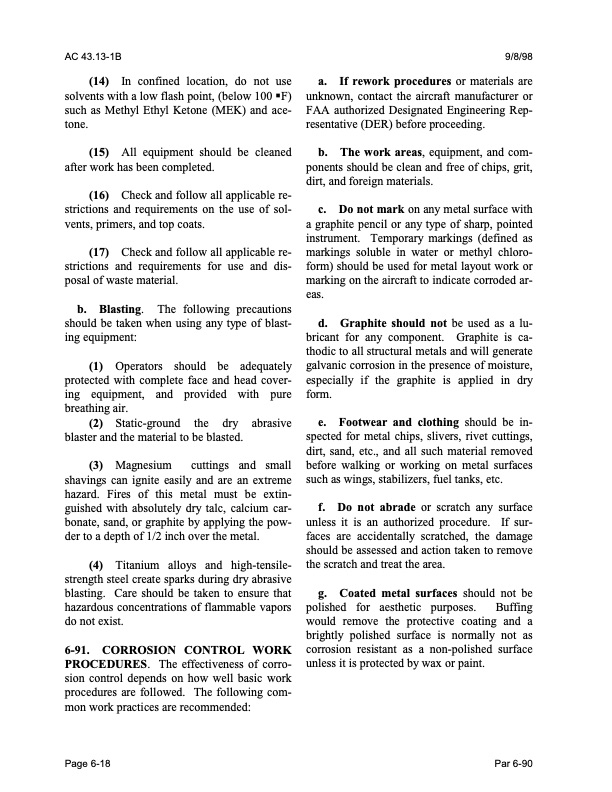
PDF Publication Title:
Text from PDF Page: 289
AC 43.13-1B 9/8/98 (14) In confined location, do not use solvents with a low flash point, (below 100 �F) such as Methyl Ethyl Ketone (MEK) and ace tone. (15) All equipment should be cleaned after work has been completed. (16) Check and follow all applicable re strictions and requirements on the use of sol vents, primers, and top coats. (17) Check and follow all applicable re strictions and requirements for use and dis posal of waste material. b. Blasting. The following precautions should be taken when using any type of blast ing equipment: (1) Operators should be adequately protected with complete face and head cover ing equipment, and provided with pure breathing air. (2) Static-ground the dry abrasive blaster and the material to be blasted. (3) Magnesium cuttings and small shavings can ignite easily and are an extreme hazard. Fires of this metal must be extin guished with absolutely dry talc, calcium car bonate, sand, or graphite by applying the pow der to a depth of 1/2 inch over the metal. (4) Titanium alloys and high-tensile strength steel create sparks during dry abrasive blasting. Care should be taken to ensure that hazardous concentrations of flammable vapors do not exist. 6-91. CORROSION CONTROL WORK PROCEDURES. The effectiveness of corro sion control depends on how well basic work procedures are followed. The following com mon work practices are recommended: a. If rework procedures or materials are unknown, contact the aircraft manufacturer or FAA authorized Designated Engineering Rep resentative (DER) before proceeding. b. The work areas, equipment, and com ponents should be clean and free of chips, grit, dirt, and foreign materials. c. Do not mark on any metal surface with a graphite pencil or any type of sharp, pointed instrument. Temporary markings (defined as markings soluble in water or methyl chloro form) should be used for metal layout work or marking on the aircraft to indicate corroded ar eas. d. Graphite should not be used as a lu bricant for any component. Graphite is ca thodic to all structural metals and will generate galvanic corrosion in the presence of moisture, especially if the graphite is applied in dry form. e. Footwear and clothing should be in spected for metal chips, slivers, rivet cuttings, dirt, sand, etc., and all such material removed before walking or working on metal surfaces such as wings, stabilizers, fuel tanks, etc. f. Do not abrade or scratch any surface unless it is an authorized procedure. If sur faces are accidentally scratched, the damage should be assessed and action taken to remove thescratchandtreatthearea. g. Coated metal surfaces should not be polished for aesthetic purposes. Buffing would remove the protective coating and a brightly polished surface is normally not as corrosion resistant as a non-polished surface unless it is protected by wax or paint. Page 6-18 Par 6-90PDF Image | AFS-640

PDF Search Title:
AFS-640Original File Name Searched:
ac_43.13-1b_w-chg1.pdfDIY PDF Search: Google It | Yahoo | Bing
5,000 BF Shipping Container Lumber Dry Kiln For Quality Lumber The 5,000 BF container kiln consists of one 40 foot high-cube aluminum shipping container... More Info
Shipping Container Lumber Dry Kilns by Global Energy Global Energy designed and developed the container kiln back in 1991. The purpose is to give access to portable sawmill owners, furniture makers, and small business the value added profit of dry kiln lumber and quality hardwoods... More Info
Vacuum Kiln Conversion Kit for Lumber and Wood Dry Kilns Convert your existing conventional dry kiln into a fast drying vacuum kiln. Similar to vacuum bagging in the boat building and aircraft industry, we have come up with a proprietary process which allows you to build a very simple vacuum kiln at a fraction of the price, and without the intensive conventional metal chamber structure... More Info
Vacuum Pump Cart System for Bagging Clamping Wood Drying and more Vacuum Cart with 2HP Pump and Dual Pistons with multiple multiplex vacuum ports and liquid reservoir... More Info
Vacuum Bagging Basics Vacuum bagging is a method of clamping, which has traditionally been used in the composites industry, but can also be used for vacuum drying materials, including wood products... More Info
| CONTACT TEL: 608-238-6001 Email: greg@globalmicroturbine.com | RSS | AMP |